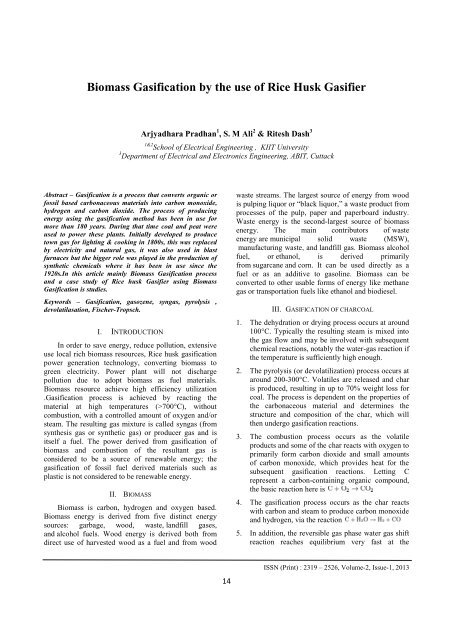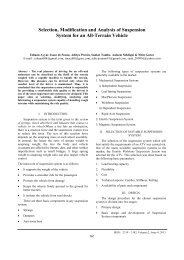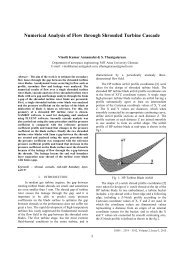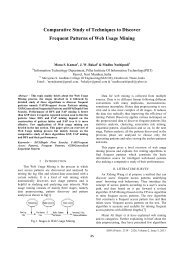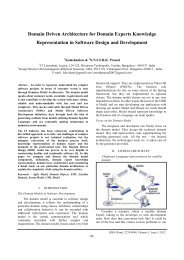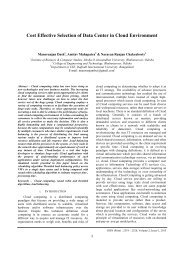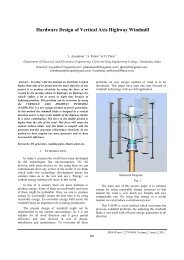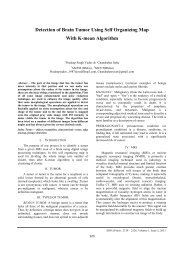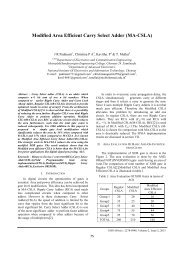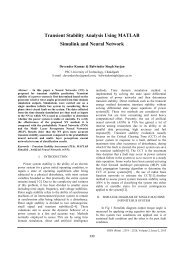Biomass Gasification by the use of Rice Husk Gasifier - IRD India
Biomass Gasification by the use of Rice Husk Gasifier - IRD India
Biomass Gasification by the use of Rice Husk Gasifier - IRD India
You also want an ePaper? Increase the reach of your titles
YUMPU automatically turns print PDFs into web optimized ePapers that Google loves.
Special Issue <strong>of</strong> International Journal on Advanced Computer Theory and Engineering (IJACTE)temperatures in a gasifier. This balances <strong>the</strong>concentrations <strong>of</strong> carbon monoxide, steam, carbondioxide and hydrogen.IV. ADVANTAGES OF GASIFICATIONThe advantage <strong>of</strong> gasification is that using <strong>the</strong>syngas is potentially more efficient than directcombustion <strong>of</strong> <strong>the</strong> original fuel beca<strong>use</strong> it can becombusted at higher temperatures or even in fuel cells,so that <strong>the</strong> <strong>the</strong>rmodynamic upper limit to <strong>the</strong> efficiencydefined <strong>by</strong> Carnot's rule is higher or not applicable.Syngas may be burned directly in gas engines, <strong>use</strong>d toproduce methanol and hydrogen, or converted via <strong>the</strong>Fischer-Tropsch process into syn<strong>the</strong>tic fuel. <strong>Gasification</strong>can also begin with material which would o<strong>the</strong>rwisehave been disposed <strong>of</strong> such as biodegradable waste. Inaddition, <strong>the</strong> high-temperature process refines outcorrosive ash elements such as chloride and potassium,allowing clean gas production from o<strong>the</strong>rwiseproblematicfuels.VII. STRUCTURE OF RICE HUSK GASIFIER SYSTEMThe gasification system includes:1. Feeder2. Circulation fluidized bed gasifier3. Cyclone separator4. Air pre heater5. Blower6. Induced draft fan7. Ash device8. Automatic controlling deviceVIII. TECHNOLOGY ROUTEThe Technology Route adopt combination <strong>of</strong>circulation fluidized bed gasification furnace andinternal combustion engine to achieve utilization <strong>of</strong> ricehusk resource. Meanwhile, according to clients demand,surplus heat boiler will be <strong>use</strong>d for collect <strong>the</strong> surplusheat <strong>of</strong> fuel gas and exhaust gas from generator,finishing comprehensive utilization <strong>of</strong> energy.IX. PROCESSFig : Shows various zone <strong>of</strong> <strong>Gasifier</strong>V. TYPES OF GASIFIER‣ counter-current fixed bed‣ co-current fixed bed‣ fluidized bed‣ entrained flow‣ plasma‣ free radicalVI. RICE HUSK GASIFIER<strong>Rice</strong> husk will be main fuel material <strong>of</strong> <strong>Rice</strong> huskgasifier power generation plants, <strong>the</strong> analysis <strong>of</strong> ricehusk is given as an example.As shown, <strong>the</strong> gasifier is a small unit with 40-cmdiameter reactor equipped with 3-in., 220-volt electricblower to provide <strong>the</strong> air needed in gasifying rice husksto produce carbon monoxide (CO) and hydrogen (H2)gases. <strong>Rice</strong> husk is fed at <strong>the</strong> top end <strong>of</strong> <strong>the</strong> reactorei<strong>the</strong>r manually using a ladder or with <strong>the</strong> <strong>use</strong> <strong>of</strong> abucket elevator. On <strong>the</strong> o<strong>the</strong>r hand, char is removedfrom beneath <strong>the</strong> char box using a screw conveyor. Thegas coming out <strong>of</strong> <strong>the</strong> reactor is conditioned <strong>by</strong> allowingit to pass through <strong>the</strong> gas-cleaning devices whichconsisted <strong>of</strong> wet scrubbers, tar condenser, and a series <strong>of</strong>packed and bag filters. The gas is fueled to a 3-cylinder,12-valve surplus Susuki engine which directly drive a10-kWe AC synchronous generator at a speed <strong>of</strong> 1,800rpm producing 220 volt current. A total <strong>of</strong> 160 pieces <strong>of</strong>50-watt bulbs can be energized <strong>by</strong> <strong>the</strong> plant for 8 to 10hours continuous operation. The plant consumes ricehusks at an average rate <strong>of</strong> 19 kg per hour. The gastemperature coming out <strong>of</strong> <strong>the</strong> reactor ranges from 400to 550°C. It dropped between 50 to 70°C after passing<strong>the</strong> wet scrubbers, and fur<strong>the</strong>r cooled down between 35to 42°C before entering <strong>the</strong> intake manifold <strong>of</strong> <strong>the</strong>engine. Gas flow rate is at 24 Nm3 per hour. The engineis entirely fueled <strong>by</strong> <strong>the</strong> gas generated, except at <strong>the</strong>start-up and at <strong>the</strong> end <strong>of</strong> <strong>the</strong> operation. Fur<strong>the</strong>rmore, aparasitic load <strong>of</strong> 15% <strong>of</strong> <strong>the</strong> power output is needed torun <strong>the</strong> plant itself.15ISSN (Print) : 2319 – 2526, Volume-2, Issue-1, 2013
Special Issue <strong>of</strong> International Journal on Advanced Computer Theory and Engineering (IJACTE)temperature, recycling and heating materials, rice huskin gasifier meet air accessing from bottom so thathydrogenation & gasification reaction occurred, and ricehusk converted into fuel gas. The element <strong>of</strong> fuel gas:CO、H 2 、CH 4 etc. Calorific value: 1450kcal/ m 3approximately. Moreover, including a little tar. Throughinnovated fuel gas purification technology, dust, tarincluded in fuel gas is effectively treated and collect tocompletely achieve <strong>the</strong> demand <strong>of</strong> internal combustion.XIII. CONCLUSIONWith <strong>the</strong> increasing industrialization and rapidpopulation growth non renewable fuels are rapidlygetting consumed, which may lead to risk <strong>of</strong> energyshortage in <strong>the</strong> future, but a definite solution to it is <strong>the</strong><strong>use</strong> <strong>of</strong> renewable source. <strong>Biomass</strong> is conversion <strong>of</strong> wasteto energy. <strong>India</strong> being a major agricultural country ricehusk gasifiers produce a change in <strong>the</strong> energy scenario<strong>of</strong> <strong>the</strong> country.XIV. ACKNOWLEDGEMENTWe would like to thank School <strong>of</strong> ElectricalEngineering, KIIT University for providing necessaryexperimental platform for research and analysis for <strong>the</strong>completion <strong>of</strong> <strong>the</strong> paper.XV. REFERENCES[1] National Non-Food Crops Centre. "Review <strong>of</strong>Technologies for <strong>Gasification</strong> <strong>of</strong> <strong>Biomass</strong> andWastes, NNFCC 09-008", Retrieved on 2011-06-24[2] The Clean and Renewable Energy Source,www.biomass.uk.com, accessed 16.05.11[3] Thermal <strong>Gasification</strong> <strong>of</strong> <strong>Biomass</strong>, International EnergyAgency Task 33, www.gastechnology.org, accessed16.05.11[4] Clean Renewable Fuel from <strong>the</strong> Plasma <strong>Gasification</strong> <strong>of</strong>Waste, www.waste-management-world.com, Accessed16.05.2011[5] Gas Generator Project History <strong>of</strong> <strong>the</strong> Gasogenetechnology[6] Beychok, M.R., Process and environmental technologyfor producing SNG and liquid fuels, U.S. EPA reportEPA-660/2-75-011, May 1975[7] Beychok, M.R., Coal gasification for clean energy,Energy Pipelines and Systems, March 1974[8] Beychok, M.R., Coal gasification and <strong>the</strong> Phenosolvanprocess, American Chemical Society 168th NationalMeeting, Atlantic City, September 1974.17ISSN (Print) : 2319 – 2526, Volume-2, Issue-1, 2013


